Cooperative Observer Network Daily Weather Observations
- Doing Something About Weather!
- Uses for Observer Data
- A Rich and Prestigious History
- Foundation of NOAA Weather Data
Doing Something About the Weather!
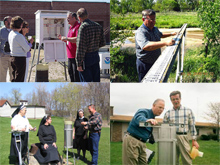
Over 11,000 volunteer citizens across the country take daily weather readings as part of the Cooperative Observer Network Program, helping to build and maintain the cornerstone of our nation's climatological record. Officials estimate that volunteer observers contribute over one million hours of service per year! Click image for larger view.
The NOAA National Weather Service (NWS) Cooperative Observer Program (COOP) truly is the nation's weather and climate observing network of, by, and for the people.
Cooperative observers have given scientists and researchers continuous observational weather data since the program's inception more than a century ago in the late 1800s. Today more than 11,000 volunteers take observations on farms, in urban and suburban areas, national parks, seashores, and mountaintops. The stations where cooperative observers collect weather and climate data truly are representative of where people live, work, and play.
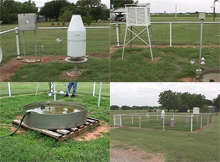
Cooperative observer network observation station. Top left: precipitation recording gage; top right: instrument shelter for recording maximum and minimum air temperature; bottom left: evaporation pan; bottom right; an observation station. With a few exceptions, the instruments used by cooperative observers have not changed significantly over the past century. Click image for larger view.
Most observers provide daily reports on air temperature, precipitation, and other weather factors such as snow depth, river levels, and soil temperature, and send those reports monthly to the NOAA National Climatic Data Center or an NWS office. Many cooperative observers provide additional hydrological or meteorological data, such as evaporation, soil moisture, and water temperature. Observers transmit their data via telephone, computer, or mail. Equipment used at cooperative observer stations may be owned by NWS, the observer, or by a company or other government agency as long as it meets NWS equipment standards.
Uses for Observer Data
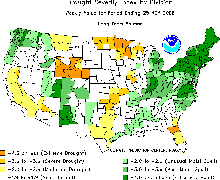
NOAA’s National Weather Service incorporates data from cooperate network weather observers into a number of products including the long-term drought severity index as displayed on this map. Click image for larger view.
The National Weather Service uses data from the Cooperative Observer Network in a number of products to keep the American public informed on current climate and weather information. Some of these products include:
- Snowfall and snow depth maps
- Hourly precipitation data
- Heating and cooling degree day data
- Long-term drought index
- Temperature and precipitation trends
- Probability of temperature and precipitation exceedance forecasts
- Crop moisture index
A Rich and Prestigious History
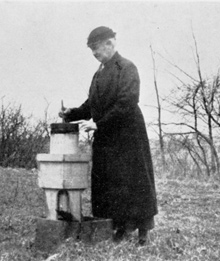
Miss Louisa B. Knapp, cooperative observer at Plymouth, Massachusetts, for 49 years, photographed in November 1935. Click image for larger view.
The first network of cooperative stations was set up by an act of Congress in 1890 that established the U.S. Weather Bureau. But many observer stations began operation long before that time. John Campanius Holm's weather records, taken without the benefit of instruments in 1644-45, were the earliest known observations in the United States. Subsequently, many persons, including George Washington, Thomas Jefferson, and Benjamin Franklin, maintained weather records. Thomas Jefferson maintained an almost unbroken record of weather observations between 1776 and 1816, and George Washington took his last observation just a few days before he died. Two of the most prestigious awards given to cooperative weather observers are named after Holm and Jefferson.
The Bedrock and Foundation of NOAA Weather Data
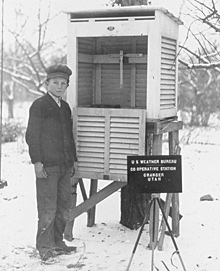
Volunteers observed temperature, precipitation, and sky conditions at a cooperative weather station in Granger, Utah, circa 1930. Click image for larger view.
Because of its many decades of relatively stable operation, high station density, and high proportion of rural locations, the Cooperative Observer Network has been recognized as the most definitive source of information on U.S. climate trends for temperature and precipitation. Cooperative stations form the core of the U.S. Historical Climate Network and the U.S. Reference Climate Network.
NOAA’s cooperative weather observers are the bedrock of weather data collection and analysis for the U.S. Long and continuous records provide an accurate picture of a locale's normal weather, and give climatologists and others a basis for predicting future trends. These data are invaluable for scientists studying floods, droughts and heat and cold waves. Satellites and other technological breakthroughs have brought great benefits in terms of better forecasts and warnings, but without the century-long accumulation of accurate weather observations, conscientiously taken by volunteer observers, scientists could not begin to adequately describe the climate of the United States.










